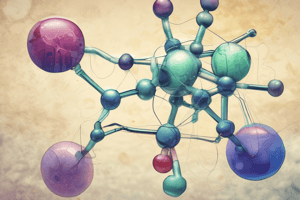Podcast
Questions and Answers
Biochemistry is most accurately described as the study of biological processes using which field?
Biochemistry is most accurately described as the study of biological processes using which field?
- Chemistry (correct)
- Astronomy
- Physics
- Geology
Which of the following careers directly benefits from a strong understanding of biochemistry?
Which of the following careers directly benefits from a strong understanding of biochemistry?
- History
- Architecture
- Medicine (correct)
- Software Engineering
What role does biochemistry play in the field of agriculture?
What role does biochemistry play in the field of agriculture?
- Designing irrigation systems.
- Understanding medicinal crops. (correct)
- Developing new types of farm machinery.
- Predicting weather patterns.
A carbohydrate is classified as an oligo-saccharide when it contains how many monosaccharide units?
A carbohydrate is classified as an oligo-saccharide when it contains how many monosaccharide units?
What is the general chemical formula for carbohydrates?
What is the general chemical formula for carbohydrates?
Besides carbon, hydrogen, and oxygen, which other elements can be found in carbohydrates?
Besides carbon, hydrogen, and oxygen, which other elements can be found in carbohydrates?
To which family, D or L, do most carbohydrates belong?
To which family, D or L, do most carbohydrates belong?
What distinguishes an aldose from a ketose?
What distinguishes an aldose from a ketose?
Which of the following monosaccharides does not contain any asymmetric centers?
Which of the following monosaccharides does not contain any asymmetric centers?
What structural feature is responsible for the existence of optical isomers (enantiomers) in monosaccharides?
What structural feature is responsible for the existence of optical isomers (enantiomers) in monosaccharides?
Flashcards
What is Biochemistry?
What is Biochemistry?
Using chemistry to study biological processes.
What are Carbohydrates?
What are Carbohydrates?
Polyhydroxy aldehydes or ketones, or substances that yield such compounds on hydrolysis.
Carbohydrate Classification
Carbohydrate Classification
Monosaccharides are single sugar units; oligosaccharides contain 2-10 units; polysaccharides contain more than 10.
Significance of Carbohydrates
Significance of Carbohydrates
Signup and view all the flashcards
What is an Aldose?
What is an Aldose?
Signup and view all the flashcards
What is a Ketose?
What is a Ketose?
Signup and view all the flashcards
Glucose vs. Fructose
Glucose vs. Fructose
Signup and view all the flashcards
D-Ribose and 2-Deoxy-D-Ribose
D-Ribose and 2-Deoxy-D-Ribose
Signup and view all the flashcards
Asymmetric Centers
Asymmetric Centers
Signup and view all the flashcards
Glyceraldehyde Isomers
Glyceraldehyde Isomers
Signup and view all the flashcards
Study Notes
- The use of chemistry to study biological processes defines biochemistry.
Benefits of Biochemistry
- Crucial for science fields like medicine and pharmacy.
- Essential to understand medicinal crops for agriculture.
- Necessary to produce good crop strains, leading to botany careers.
- Food Industry expert knowledge in nutritional values.
Semester Studies
- Dr. Manar: Focuses on carbohydrates, lipids, and proteins.
- Dr. Omran: Covers DNA, vitamins, peptide hormones.
Carbohydrates
- Polyhydroxy aldehydes or ketones.
- Yield compounds upon hydrolysis.
- The general chemical formula is (CnH2nOn) or 2(CH2O).
- May contain nitrogen (N), phosphorus (P), or sulfur (S).
Classification of Carbohydrates
- Monosaccharides: Consist of one sugar unit.
- Oligosaccharides: Contain 2 to 10 sugar units.
- Polysaccharides: Composed of 10 or more sugar units.
- The most abundant and important organic compound for animals and plants.
- Produced from photosynthesis.
- Most carbohydrates belong to the D-family, not the L-family.
Monosaccharides
- Are nonpolar solids that do not dissolve in water.
- They have a sweet taste .
- If the monosaccharide contains an aldehyde group, it is an aldose.
- If it contains a ketone group, it is a ketose.
- Monosaccharides typically have four to seven carbons, except for C3.
- D-Glyceraldehyde is an aldotriose.
- Dihydroxyacetone is a ketotriose.
- D-Glucose is an aldohexose.
- D-Fructose is a ketohexose.
- D-Ribose and 2-Deoxy-D-Ribose are components of nucleotides and nucleic acids.
Ketose vs. Aldose
- To identify, check the location of the group.
- For ketose, and for aldose, .
- Monosaccharides have asymmetric centers, except for dihydroxyacetone.
- Contain one or more asymmetric (chiral) carbon atoms.
- Occur in optically active isomeric forms.
- Glyceraldehyde, the simplest aldose, contains one chiral center.
- Glyceraldehyde has two different optical isomers or enantiomers.
Examples of Monosaccharides
- Mannose, Glucose, and Galactose differ from each other.
- Mannose and Glucose differ at C2.
- Galactose and Glucose differ at C4.
- Epimers: Differ in one carbon configuration.
- If one sugar is similar to the other, one is labeled from group D, and the other from Group L.
- D and L are determined by the location of the OH group.
- If the OH group is on the right, it is D.
- If the OH group is on the left, it is L.
Studying That Suits You
Use AI to generate personalized quizzes and flashcards to suit your learning preferences.
Related Documents
Description
Explore the basics of biochemistry, its benefits in medicine, agriculture, and the food industry. Learn about carbohydrates, including their classification, structure, and importance in both animals and plants.




